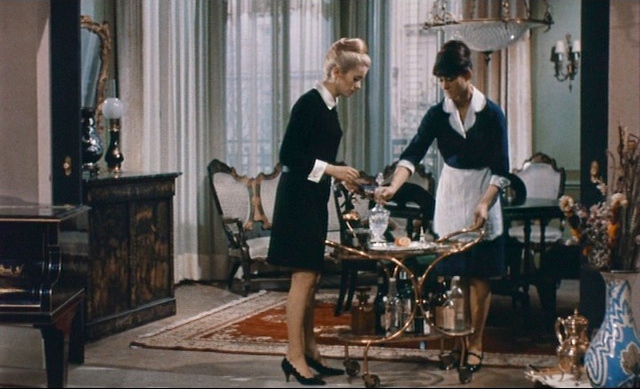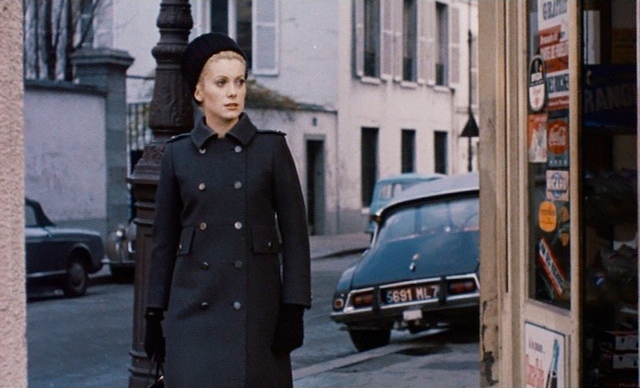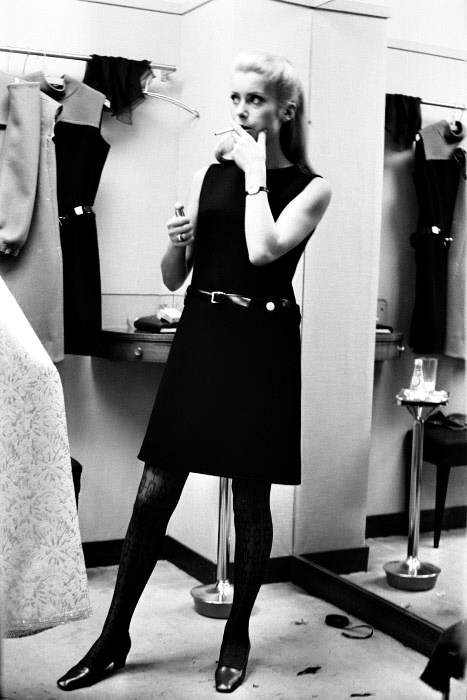From the beginning of Luis Bunel‘s 1967 classic Belle de Jour, audiences are awash in his signature surrealism and aroused by an eroticism that has made this movie his masterpiece. The story centers on Severine Serizy, a beauty blonde wife who, despite having a loving husband, discovers a need to live out her sexual fantasies as a whore. It is based on the 1928 eponymous novel by Joseph Kessel. In 2006 the Portuguese director, Manoel de Oliveira released Belle Toujours, imagining a future encounter between two of the central characters from the original film.
The title is a pun in French. The phrase “belle de nuit” is best translated by the English phrase “lady of the night”, i.e. a prostitute. Séverine works as a prostitute during the day, so she is “belle de jour”. It may also be a reference to the French name of the day lily (Hemerocallis), meaning “beauty of [the] day”, a flower that blooms only during the day.
Perfectly played by a 23-year-old Catherine Deneuve, it’s easy to see how the part made her an international star. Her performance is subtle, remaining cool even as Severine’s experiences fluctuate between pleasure and pain…morality and immorality…and exploring just how subjective each of those extremes are. Despite the storyline, the sexuality never seems too strong and much of this has to do with the film’s now iconic style. Classic and timeless with a twist of fetish, Belle de Jour‘s costumes are courtesy of fashion designer Yves Saint Laurent.

 In the ski resort Séverine is wearing a beautiful cream sweater with asymmetrical zips. A very interesting shorter sleeve length, above the wrist, leaving room to show the white cuffs of the garment underneath.
In the ski resort Séverine is wearing a beautiful cream sweater with asymmetrical zips. A very interesting shorter sleeve length, above the wrist, leaving room to show the white cuffs of the garment underneath.
 In a tennis attire
In a tennis attire

 The safari dress. Sand tone, patch pockets, chain gold belt, fly front zip, epaulettes, shirt cuffs. In the sixties Yves Saint Laurent marked a turning point in the safari style with his iconic jacket.
The safari dress. Sand tone, patch pockets, chain gold belt, fly front zip, epaulettes, shirt cuffs. In the sixties Yves Saint Laurent marked a turning point in the safari style with his iconic jacket.



 Another incredible piece in Severine’s wardrobe is this YSL vinyl trench coat. Black patent trench coat with wool sleeves and very thin belt. A coat she’s wearing when she goes back to the brothel, a sign that she wants to continue with her double life. Tortoiseshell rimmed sunglasses.
Another incredible piece in Severine’s wardrobe is this YSL vinyl trench coat. Black patent trench coat with wool sleeves and very thin belt. A coat she’s wearing when she goes back to the brothel, a sign that she wants to continue with her double life. Tortoiseshell rimmed sunglasses.





 Down comes the prim and proper updo as Severine assumes the role of Belle de Jour. The hairstyle once again demonstrates the difference between Severine, the good wife and a return to being Belle de Jour
Down comes the prim and proper updo as Severine assumes the role of Belle de Jour. The hairstyle once again demonstrates the difference between Severine, the good wife and a return to being Belle de Jour


 The elegance of a monochromatic outfit. Fur trimmed brown leather coat, double breasted, leather buttons, rear vent and half belt back. Accessorized with short brown leather gloves and tote.
The elegance of a monochromatic outfit. Fur trimmed brown leather coat, double breasted, leather buttons, rear vent and half belt back. Accessorized with short brown leather gloves and tote.



 Under the sumptuous leather coat she is wearing a sleeveless, slightly flared dress, in the same brown colour. The simplicity of this trapéze dress is exceptional
Under the sumptuous leather coat she is wearing a sleeveless, slightly flared dress, in the same brown colour. The simplicity of this trapéze dress is exceptional

 Note scalloped edges of the black pumps (most likely Roger Vivier, who originated the stiletto heel) that are paired with this seemingly innocent frock
Note scalloped edges of the black pumps (most likely Roger Vivier, who originated the stiletto heel) that are paired with this seemingly innocent frock

 The YSL “school girl” dress–whose design owes a lot to 1930s film fashion as well as Chanel– has become iconic in fashion today
The YSL “school girl” dress–whose design owes a lot to 1930s film fashion as well as Chanel– has become iconic in fashion today



 Almost all of Séverine’s clothes are military inspired, referring to the rigorous way she lives her life as a bourgeois. The grey wool coat she wears when she steps into the brothel for the first time is double-breasted, ventless, with wide-spread collar, epaulettes and just above the wrist sleeves.
Almost all of Séverine’s clothes are military inspired, referring to the rigorous way she lives her life as a bourgeois. The grey wool coat she wears when she steps into the brothel for the first time is double-breasted, ventless, with wide-spread collar, epaulettes and just above the wrist sleeves.

 Two-tone red, slightly A-line dress with button shoulder straps and belt, worn with a short red Eisenhower jacket, double breasted.
Two-tone red, slightly A-line dress with button shoulder straps and belt, worn with a short red Eisenhower jacket, double breasted.



 Red and white, very symbolic colors that reminds a little bit to Saint Sebastian’s martyrdom
Red and white, very symbolic colors that reminds a little bit to Saint Sebastian’s martyrdom

 Another aspect of Deneuvian style are Roger Vivier’s legendary “pilgrim” pumps, which she favored both on and off screen along with other timeless style icons like Jacqueline Kennedy Onassis
Another aspect of Deneuvian style are Roger Vivier’s legendary “pilgrim” pumps, which she favored both on and off screen along with other timeless style icons like Jacqueline Kennedy Onassis
 The Last Metro by Jonathan Burton
The Last Metro by Jonathan Burton







































































































